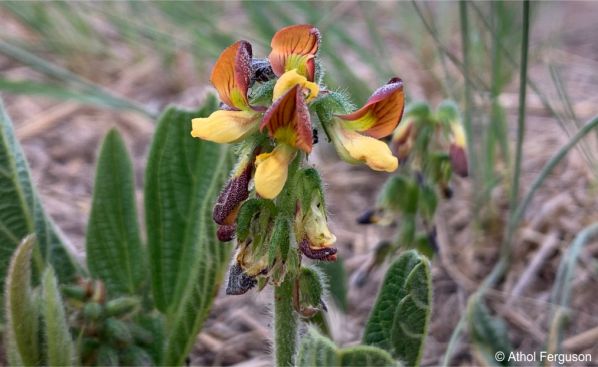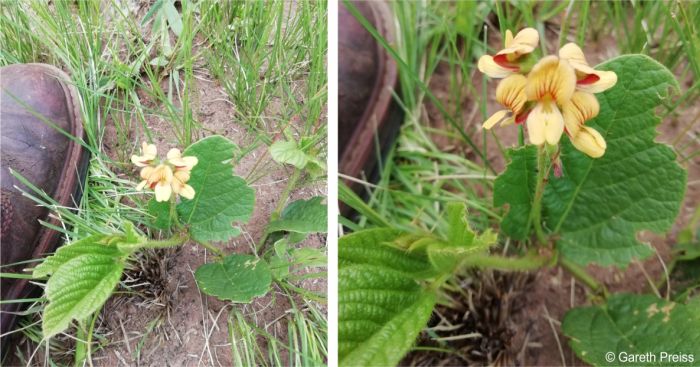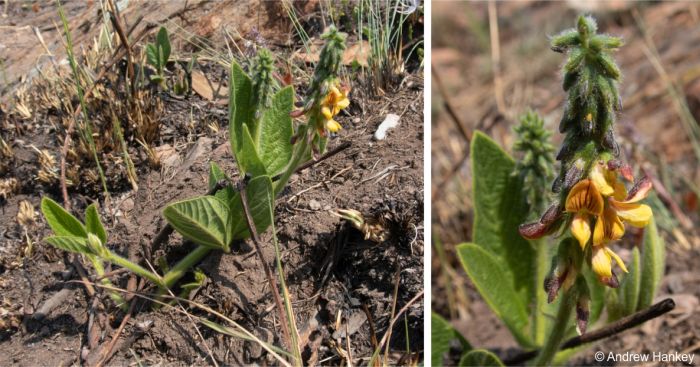Eriosema cordatum
Eriosema cordatum E.Mey.
Family: Fabaceae
Common names: heart-leaf eriosema (Eng.); leshetla (Sesotho); ubangalala, umhlabankunzi (isiZulu)
Introduction
Eriosema cordatum is a fascinating plant known for its aphrodisiac and medicinal properties, beautiful vibrant flowers and heart-shaped leaves, which make it an excellent choice for small gardens, adding charm, visual appeal and ecological value. This plant belongs to the legume family, which includes many other important species like beans and peas. Its ecological and medicinal importance make it a significant subject of study and appreciation. Not only is Eriosema cordatum valued for its aesthetic appeal, but it also plays a crucial role in various ecosystems. Understanding this plant can help us appreciate the diversity of plant life and the interconnectedness of nature.

Description
Description
Eriosema cordatum is a low-growing, herbaceous plant that often forms a dense mat on the ground. Its stems are slender and can spread extensively, creating a carpet-like appearance. Borne on the hairy stem, the leaves are heart-shaped, which is a distinctive feature of this species. They are bright green and have a shiny surface, which adds to the plant’s attractiveness. This plant produces terminal inflorescences, up to about 50 mm long, throughout the year, but are most showy in the summer months. The flowers are typically yellow or orange, with reddish-brown stripes. The blooming period can vary, but when in full bloom, the plant can create a stunning display of colour. After flowering, rounded, flat, hairy pods about 15 mm long are produced.

Conservation Status
Status
Eriosema cordatum is classified as Least Concern according to the SANBI Red List of South African Plants.
Distribution and habitat
Distribution description
Eriosema cordatum is predominantly found in the eastern parts of the country. It also extends to Eswatini, Mozambique, Zimbabwe and Botswana. It thrives in open grassland, where it benefits from ample sunlight and minimal competition from taller plants. This plant is well-adapted to the warm climates of these regions, and it is versatile, which allows it to flourish in a variety of habitats. The plant will grow in sandy, loamy, and even rocky soils. It is often found along riverbanks and in savanna, where it can take advantage of the well-drained soils. Its ability to adapt to different soil types makes it a resilient species capable of surviving in diverse conditions.

Derivation of name and historical aspects
History
The genus name Eriosema is derived from the Greek words erion, meaning ‘wool’, and sema, meaning ‘banner’, or ‘sign’, referring to the hairs on the standard petal in this genus. The species name cordatum is Latin for ‘heart-shaped’, aptly describing the shape of the plant’s leaves. These names reflect the key characteristics that make this plant easily identifiable.
Historically, the Eriosema genus has been studied extensively due to its wide distribution and ecological significance. The Fabaceae, or legume family, to which Eriosema cordatum belongs, includes many economically and ecologically important plants. This family is known for its nitrogen-fixing ability, which enriches the soil and supports other plant species. The study of Eriosema cordatum and its relatives provides valuable insights into plant ecology and evolution.
Ecology
Ecology
Eriosema cordatum plays a crucial role in its ecosystem by stabilising soil and preventing erosion, especially in areas prone to heavy rains. Its low-growing habit and dense mat of stems and leaves help hold the soil in place, particularly in open grasslands and along riverbanks. In addition to its soil-stabilising properties, Eriosema cordatum is an important food source for various insects and small animals. Its flowers attract pollinators like bees and butterflies, which are essential for the reproduction of many plant species. By supporting these pollinators, Eriosema cordatum indirectly contributes to the health and diversity of its ecosystem.

Uses
Use
Eriosema cordatum is used by the Zulu people as a natural sexual booster due to its aphrodisiac properties. It is also used to treat impotence. Nguni cattle farmers use it to stimulate their bulls in spring for mating. It also has various other uses in traditional medicine, with some communities in Mozambique using its leaves to treat wounds and infections, believing in its healing properties. While scientific studies on its medicinal uses are limited, traditional knowledge highlights the plant’s potential benefits.
Culturally, Eriosema cordatum is valued for its aesthetic appeal. Its vibrant flowers and attractive leaves make it a popular choice for gardens and decorative purposes. Additionally, its role in promoting soil health and supporting biodiversity underscores its ecological importance, making it a plant of cultural and environmental significance.
Growing Eriosema cordatum
Grow
Propagating of Eriosema cordatum is done through seeds. It is essential to sow them in well-draining soil and keep them consistently moist until germination occurs. This process usually takes a few weeks. After the emergence of the seedlings, ensure that they remain in a warm and humid environment until the second true leaf is observed.
To cultivate Eriosema cordatum, choose a location with plenty of sunlight, as this plant thrives in bright conditions. The soil should be rich in nutrients and well-drained to prevent waterlogging, which can lead to root rot. Regular watering is essential, especially during dry periods, but avoid overwatering. Remove any dead or damaged stems to promote healthy development. Fertilizing the plant with a balanced, slow-release fertilizer can provide the necessary nutrients for robust growth and vibrant flowers. With proper care, Eriosema cordatum can be a delightful addition to any garden.
References
- Burrows, J., Burrows, S., Lotter, M. & Schmidt, E. 2018. Trees and shrubs of Mozambique. Publishing Print Matters Heritage, Cape Town.
- Clarke, H. & Charters, M. 2016. The illustrated dictionary of southern African plant names. Flora & Fauna Publications Trust, Jacana, Johannesburg.
- Codd, L.E.W., Dyer, R.A., Rycroft, H.B. & Winter, B.D. 1963. Flora of Southern Africa: the Republic of South Africa, Basutoland, Swaziland and South West Africa. Government Printer. Pretoria.
- Ferguson, A. 2020. Observation of Eriosema cordatum, Krugersdorp, Gauteng. iNaturalist. Online. https://www.inaturalist.org/observations/63521105.
- Hankey, A. 2022. Observation of Eriosema cordatum, Ekurhuleni, Gauteng. iNaturalist. https://www.inaturalist.org/observations/138239057.
- Hankey, A. 2023. Observation of Eriosema cordatum, Walter Sisulu NGB, Gauteng. iNaturalist. https://www.inaturalist.org/observations/143269269.
- Launert, E., Bell, E.A., Mendes, E.J. 1985. Flora Zambesiaca: Mozambique, Malawi, Zambia, Zimbabwe, Botswana. Volume 7: Part 2. Royal Botanic Gardens. London.
- Palmer, E. & Pitman, N. 1972. Trees of southern Africa. Balkema, Cape Town.
- Pooley, E. 1998. A field guide to wild flowers of Kwazulu-Natal and the eastern region. Natal Flora Publications Trust, Durban.
- Preiss, G. 2018. Observation of Eriosema cordatum, Wartburg, KZN. iNaturalist. https://www.inaturalist.org/observations/19013112.
- Von Staden, L. 2017. Eriosema cordatum E.Mey. National Assessment: Red List of South African Plants. Accessed on 2024/07/28.
- Watt, J.M. & Breyer-Brandwijk, M.G. 1962. The medicinal and poisonous plants of southern and eastern Africa , edn 2. Livingstone, Edinburgh & London.
Credits
Mpho Mathalauga
Pretoria National Botanical Garden
August 2024
Acknowledgements: Images by Athol Ferguson, Andrew Hankey and Gareth Preiss.
Plant Attributes:
Plant Type: Ground Cover, Perennial
SA Distribution: Gauteng, KwaZulu-Natal, Limpopo, Mpumalanga, North West
Soil type: Sandy, Loam
Flowering season: Sporadic/All year
PH:
Flower colour: Red, Yellow, Orange
Aspect: Full Sun
Gardening skill: Average
Special Features:
Horticultural zones









Rate this article
Article well written and informative
Rate this plant
Is this an interesting plant?
Login to add your Comment
Back to topNot registered yet? Click here to register.